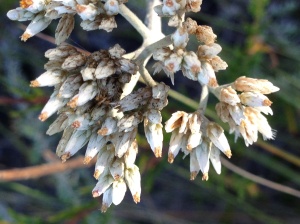Two lovely runs this week. One on a cool damp morning with the new growth of Leudadendron salignum glowing green in the grey light once again and bounding dogs enjoying the autumnal weather. The house is full of guests and it’s lovely to get up early, go for a run and enjoy my own company and that of the dogs, returning to a social breakfast full of chat and laughter before we get on with the day. Our guests are terrific, they know their way around the house and on Monday’s run I returned home to a delicious breakfast of poaches eggs with english muffins, avocado and olive oil, all prepared by Niall before he took himself off for a morning of work.
This morning was the perfect opposite in terms of weather, a typical hot dry windy morning with the heart monitor showing the heavy weather I was making of pushing up the mountain against the howling wind. The wolfhounds love the wind and stand face on, enjoying the feel of it slipping through their shaggy coats. As ever on a hot day, they enjoy a quick water break at Fox Pan as we run up the mountain and you can clearly see the wind ruffling their coats.

Seamus and Maebh enjoying water and wind
Although flowers are not prolific I can see the Cape cycle starting once again. Having grown up in the Irish climate where winter is winter and spring gets off to a slow start, this Cape climate is always a little strange to me. The slowest period is during the hot summer months of January and February. As the weather cools and the rains arrive, the whole mountain bursts into life, the flowering season starts again, lasts all winter and reaches it’s apotheosis in the spring months of September, October and November. Having been through the cycle once I am alert to the signs that the new flowering year is getting ready to launch. Murlatia hysteria is a real stalwart, along with the Salvia africana it really does flower all year long without a break, but now in anticipation of the rains it seems to be showing more blooms than ever. Here it is in the morning sunlight.

Muraltia heisteria
I cannot resist taking photos of the gorgeous Leucadendron salignum, particularly when it’s been raining which seems to set off the glowing green. There will be many more photos of this gorgeous plant during the course of the winter. It has begun its flowering season already.

Leucadendron salignum
One could do a whole blog just on grasses but as the are hard to photograph really well I tend to ignore most of them. It’s a technical subject and I have a couple of books, but not the time to identify this one which has just come into flower all over the mountain, especially in high, rather damp places.

Grasses with yellow flower
I’ve identified this as a member of the Helichrysum family. I’m still not sure that’s right but I can’t find anything else that it resembles. The flowers don’t seem very helichrysum-like to me, but I can’t find anything else that it resembles. As I was taking this photo just above Fox Pan, I realised that the dogs were very interested in the plant and really getting in to have a good sniff around. So I stopped and looked and you could clearly see that something had been lying up on top of it. Makes perfect sense, this plant is growing in front of a large protea, so it’s protected from the back, sheltered overhead and looks over Fox Pan and the whole mountain so whatever lay up there obviously felt completely safe and its lucky I didn’t run past at the wrong moment with the dogs. I presume it was a buck of some kind, we see lots of them and the dogs often put them up and give chase, but they are far far slower than any buck and don’t even try that hard. It’s lovely to see evidence of the animals who share this farm with us, whether it’s picking up a porcupine quill on a road that I’d only run the day before and imagine him shuffling up there in the dark, or seeing a plant flattened by a buck contented after her drink at Fox Pan and enjoying a rest on the mountain.

Is it Helichrysum?
We get the best sunsets at this time of year and I always try to capture and share the good ones. This was over the weekend as we sat on the balcony enjoying the house cocktail, gin and tonic with Campari.

Another perfect sunset













